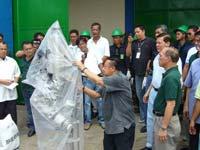Infamous connections

The United Nations Office on Drug Crime has identified The Philippines as one of the world's leading methamphetimine producers, and a major exporter of the illegal party drug to Canada.
According to the UN's new 2009 World Drug Report, The Philippines ranks fifth in the world in terms of methamphetamine (or shabu) seizures in the last 10 years and has remained a significant source of the illegal drug for the international drug trafficking industry.
The UNODC noted that The Philippines ranked only behind China and the United States, which have considerably larger populations, and Thailand and Taiwan in terms of the number of meth seizures within its borders.
The report also noted that Philippine-made shabu is shipped to Canada, Australia, New Zealand and the U.S.
“Manufacture often occurs in industrial-sized laboratories operated by transnational organized crime with most chemists being foreign nationals,” the report said.
The 314-page report written by the newly created UNODC said The Philippines remains a significant source of high potency crystal meth used both domestically and exported throughout Asia and beyond.
It said that while many countries manufactured shabu, China, Burma and The Philippines accounted for most of the production over the past decade.
A Malacañang official said this week that the branding of The Philippines as a top producer of shabu stemmed from its law enforcement agencies’ successes in dismantling illegal drug operations and clandestine laboratories in the country.
Press Secretary Cerge Remonde said it was “ironic” that the numerous inroads made by the government in curbing the illegal drug trade had earned it the tag of leading manufacturer of shabu by a UN agency.
“The irony of it is that the basis for that conclusion are the accomplishments of our Philippine drug enforcement agencies,” Remonde said in an interview over state-run Radyo ng Bayan.
The UN report said that in 2007, a notable increase in the seizure of methamphetamine-related manufacturing facilities in The Philippines was reported with nine significant laboratories and 13 chemical warehouses seized. This rose to 10 laboratories in 2008.
Easy to make, cheap to buy, and highly addictive, The Philippines is now dealing with its own meth scourge as shabu - the Philippine name for crytal meth - reportedly the new drug of choice of over 90 per cent of Filipino drug users, from college dorms to rural farms.
The comprehensive report also painted a global picture of drug trafficking, and identified interregional trafficking routes as being from Burma to Bangladesh and India; from Hong Kong, China, to Australia, Indonesia, Japan and New Zealand; from The Philippines to Australia, Canada, New Zealand, and the US; and from East and Southeast Asia to Iran, Saudi Arabia and the UAE.
The 2009 report said that global markets for cocaine, opiates and cannabis were steady or in decline, while the production and use of synthetic drugs was increasing in the developing world, including here in Canada.
Cannabis or marijuana remained the most widely used drug around the world, although estimates were less precise.
Philippine Daily Inquirer pundit Cynthia Balana wrote that the “positive point” in the report was that shabu is being seized by Philippine authorities, “but this does not dispel the fact that shabu is being manufactured in large quantities in this country, which has become a major shabu exporter and transshipment point for the international drug trafficking industry.”
In her hard-hitting coverage of the UN report's findings, added Balana: “So why does the illegal industry continue to flourish? Shabu trafficking is hugely profitable, and manufacturers have the means to buy protection from law enforcement agencies. How many of the actual operators of shabu laboratories have been arrested in raids? Only janitors and security guards are the ones usually caught, indicating that the operators are tipped off by their protectors.
“The rare times that drug dealers themselves are arrested and prosecuted, they can buy their freedom through corrupt jail guards, prosecutors, judges and immigration officers. Their release is also facilitated by the technical lapses committed by anti-narcotics agents who are poorly trained in conducting legitimate raids, searches, seizures and arrests. Such lapses can be used as a valid excuse for the dismissal of cases by corrupt prosecutors or judges.
“Fighting the drug menace takes more than piling up confiscated evidence. More importantly, drug traffickers must be caught, prosecuted and punished.”
But the report also identified Canada as playing an alarmingly prominent role in international drug trafficking, suggesting the illegal drug flow between Canada and Asia runs deep and both ways.
The report said “there is evidence that Canada-based Asian organized crime groups and outlaw motorcycle gangs have significantly increased the amount of methamphetamine they manufacture and export since 2003, for the U.S. market, but also for Oceania and East and South-East Asia.”
In Australia, the report said, methamphetamine from Canada accounted for a whopping 83 per cent of total seized imports by weight.
Canada and Mexico have also been shipping the cooked drug to the U.S., where successful efforts to shut down drug labs have left a sizeable market niche for foreign importers.
The report also said that in 2007, 50 per cent of the ecstasy produced in Canada was trafficked outside our borders.
“A lot of this seems to be transnational — international trade being organized by organized crime using mostly the west coast of Canada as a hub,” Walter Kemp, a spokesman for the UN's Office on Drugs and Crime, told the CBC.
-With News Services









